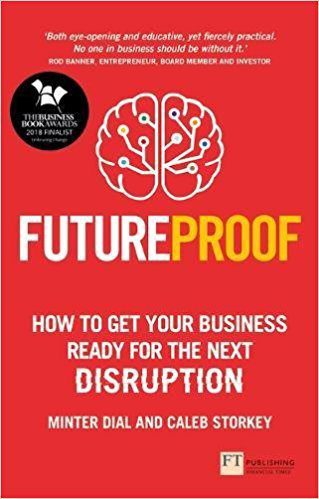Authors: Minter Dial & Caleb Storkey
Review by: Perry Timms (published in HR Director)
NOMINATED FOR THE BUSINESS BOOK AWARDS 2018

Disruption is an oft-used term for that fact that we can rent out someone’s spare room online or order a restaurant’s food to take away and someone on a pushbike delivers it to us all using an app on our phone.
Disruptive Business Models and Disruptive Innovation have been with us for a surprising long 23 years.
It’s the term used to headline this book – Future Proof – on how to get your business ready for the next disruption. Whatever that may be.
A digital branding and strategy consultant with an AI consultant as co-authors, feels like this could be one of those journeys perhaps overly obsessed with Silicon Valley’s ways; and predicting all sorts of technologically induced utopia or dystopia depending on whether you’re a Kurzweil or Lanier fan.
So does this book do what it says? Mostly, yes it does.
First of all, I found it more practical than I expected. Simpler language, not jargon-fuelled acronym fests of overly excitable futurology. It’s written gently. Philosophical quotes to open each chapter is used by many authors, but in this book they serve as a very relevant intro to what’s to come in the 21st century words of the authors.
Secondly, this felt like every useful article I’ve ever read on LinkedIn about any of this stuff had been curated, edited and set out for me to read on one plane journey to SXSW in Texas. If you don’t know what SXSW is, then this book might be a great gap filler for you. If you’ve been to SXSW, it’s my guess that you won’t need this book.
Thirdly, the book is really trying to be your field guide for the next 2 years or so. Practical advice is included in the form of a suggestion or a prompting question. My guess is that this has come from the author’s experience in consulting and advising – it feels like a consultant’s book. But that’s not necessarily a bad thing. When so many of these concepts in the book are in-development, emerging technologies of the digital and analogue sense (like collaborative economies and platform based, algorithm-led learning apps), such consultants have to get to grips with to help their clients. This book feels like it’s being helpful to “clients” who happen to be readers.
If you are thinking “So, is this book for me?” and you already read Lanier and/or Kurzweil, I’d say not.
If you’re only just a little aware of Don Tapscott, Robert Ford, Bettina Warburg, Gerd Leonhard and Nathalie Nahai, then this book will bring a lot of things they share and talk about into a digestible sprint. Through areas like the Cloud, Blockchain, 3D Printing and Cyber Security. It’s not all digital but there’s a lot of digital in here.
I come across a lot of HR professionals a bit overwhelmed by things they hear about but don’t quite understand, because such things (blockchain and AI) are not influencing their practice – yet. This book will give some people a head start on catching up. I’d even suggest this book is aimed at those in corporate roles a little bit distant from the cutting edge of new product development.
So I liked it – well put together.
Did I learn much? Not really but I still enjoyed how they presented practical advice on things that to some are far far away technologies.
Well done Minter and Caleb. I hope your readers will urge you for a revised version 3 years hence when Quantum Computing; 4D printing; Neuralinks and Nanobots are the next wave of disruptions to future proof ourselves against.
Perry Timms, Founder and Chief Energy Officer, PTHR










